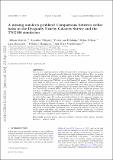Notice
This is not the latest version of this item. The latest version can be found at:https://dspace.mit.edu/handle/1721.1/132561.2
A missing outskirts problem? Comparisons between stellar haloes in the Dragonfly Nearby Galaxies Survey and the TNG100 simulation
| dc.contributor.author | Merritt, Allison | |
| dc.contributor.author | Pillepich, Annalisa | |
| dc.contributor.author | van Dokkum, Pieter | |
| dc.contributor.author | Nelson, Dylan | |
| dc.contributor.author | Hernquist, Lars | |
| dc.contributor.author | Marinacci, Federico | |
| dc.contributor.author | Vogelsberger, Mark | |
| dc.date.accessioned | 2021-09-20T18:23:03Z | |
| dc.date.available | 2021-09-20T18:23:03Z | |
| dc.identifier.uri | https://hdl.handle.net/1721.1/132561 | |
| dc.description.abstract | <jats:title>ABSTRACT</jats:title> <jats:p>Low surface brightness galactic stellar haloes provide a challenging but promising path towards unravelling the past assembly histories of individual galaxies. Here, we present detailed comparisons between the stellar haloes of Milky Way-mass disc galaxies observed as part of the Dragonfly Nearby Galaxies Survey (DNGS) and stellar mass-matched galaxies in the TNG100 run of the IllustrisTNG project. We produce stellar mass maps as well as mock g- and r-band images for randomly oriented simulated galaxies, convolving the latter with the Dragonfly point spread function (PSF) and taking care to match the background noise, surface brightness limits, and spatial resolution of DNGS. We measure azimuthally averaged stellar mass density and surface brightness profiles, and find that the DNGS galaxies generally have less stellar mass (or light) at large radii (&gt;20 kpc) compared to their mass-matched TNG100 counterparts, and that simulated galaxies with similar surface density profiles tend to have low accreted mass fractions for their stellar mass. We explore potential solutions to this apparent ‘missing outskirts problem’ by implementing several ad hoc adjustments within TNG100 at the stellar particle level. Although we are unable to identify any single adjustment that fully reconciles the differences between the observed and simulated galaxy outskirts, we find that artificially delaying the disruption of satellite galaxies and reducing the spatial extent of in-situ stellar populations result in improved matches between the outer profile shapes and stellar halo masses, respectively. Further insight can be achieved with higher resolution simulations that are able to better resolve satellite accretion, and with larger samples of observed galaxies.</jats:p> | en_US |
| dc.language.iso | en | |
| dc.publisher | Oxford University Press (OUP) | en_US |
| dc.relation.isversionof | 10.1093/MNRAS/STAA1164 | en_US |
| dc.rights | Creative Commons Attribution-Noncommercial-Share Alike | en_US |
| dc.rights.uri | http://creativecommons.org/licenses/by-nc-sa/4.0/ | en_US |
| dc.source | arXiv | en_US |
| dc.title | A missing outskirts problem? Comparisons between stellar haloes in the Dragonfly Nearby Galaxies Survey and the TNG100 simulation | en_US |
| dc.type | Article | en_US |
| dc.relation.journal | Monthly Notices of the Royal Astronomical Society | en_US |
| dc.eprint.version | Author's final manuscript | en_US |
| dc.type.uri | http://purl.org/eprint/type/JournalArticle | en_US |
| eprint.status | http://purl.org/eprint/status/PeerReviewed | en_US |
| dc.date.updated | 2020-11-17T15:09:17Z | |
| dspace.orderedauthors | Merritt, A; Pillepich, A; van Dokkum, P; Nelson, D; Hernquist, L; Marinacci, F; Vogelsberger, M | en_US |
| dspace.date.submission | 2020-11-17T15:09:24Z | |
| mit.journal.volume | 495 | en_US |
| mit.journal.issue | 4 | en_US |
| mit.license | OPEN_ACCESS_POLICY | |
| mit.metadata.status | Authority Work and Publication Information Needed |
